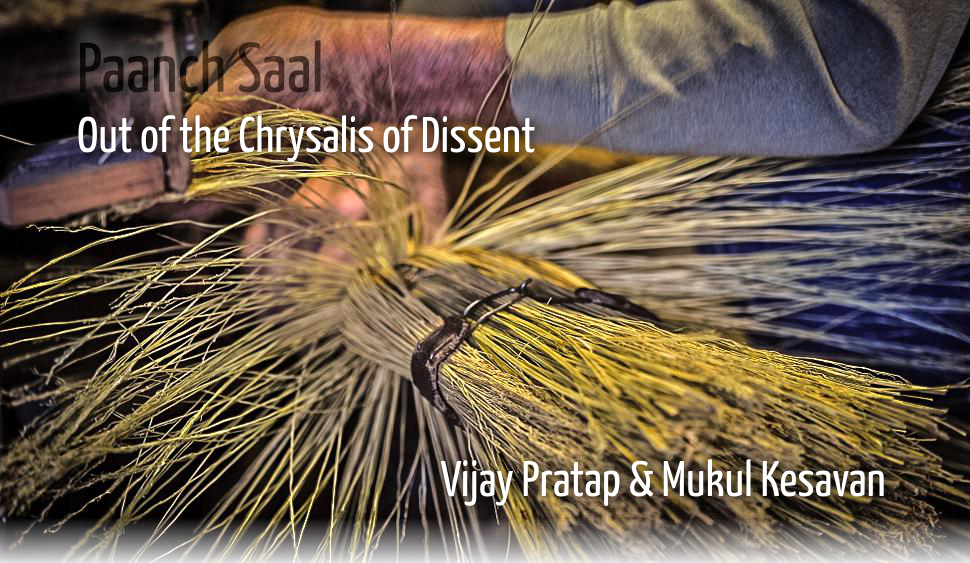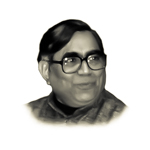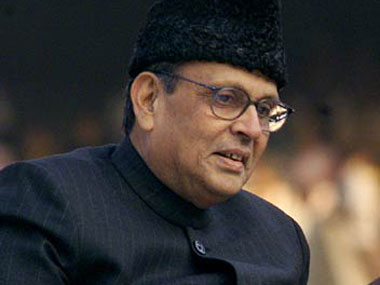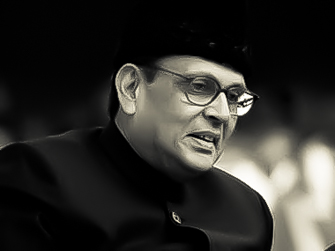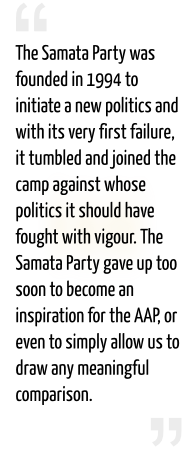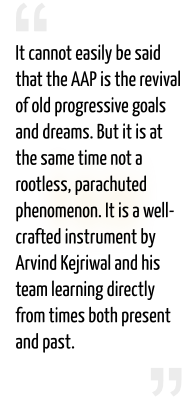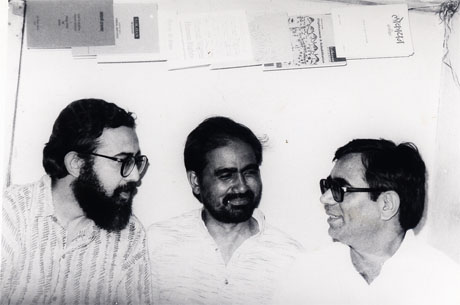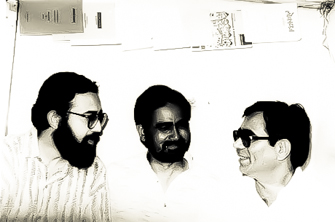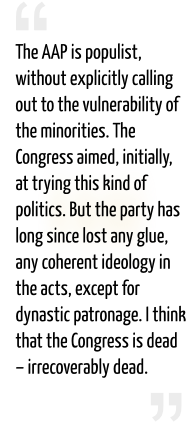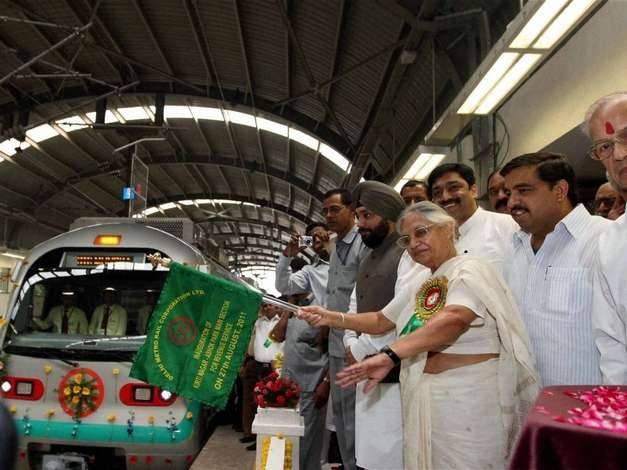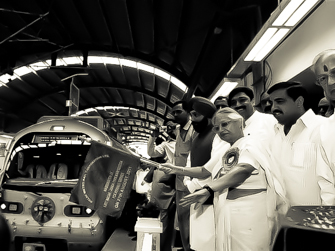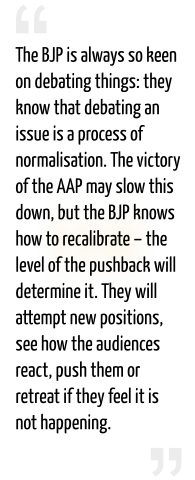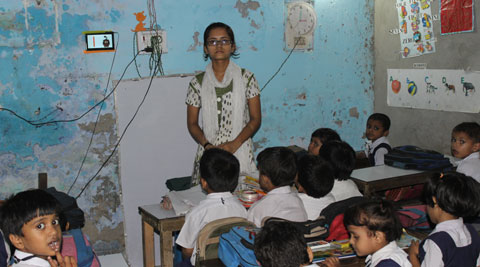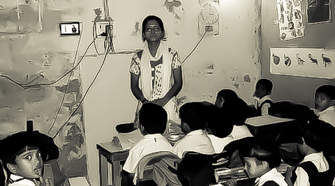
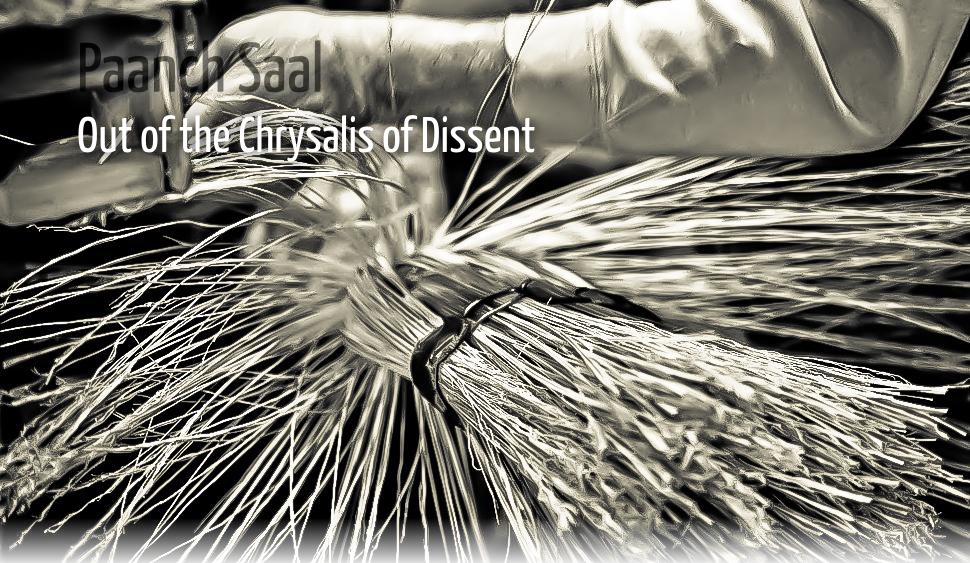
13 February 2015In the middle of things, one often forgets how fast certain turning points of history happen. One month ago, the Election Commission of Delhi had just announced the single phase for Saturday, 7 February. Kiran Bedi was not yet known as the BJP candidate. And the AAP was still facing a wide distrust after the general disappointments of last year. In media res, thus, everything took shape, showing how instantly and intensely the homo politicus ignites, readily becoming confident of taking charge of the direction of a city. Strong shoulders were mandatory for the leaders in the spotlight, as the waves of scandals, attacks, accusations, threats and mockery between competitors were not the only resistance: an always larger civil society was more informed, more expressive and critical. And the battlefield would not claim its truce without casualties. The idiosyncrasy of Kiran Bedi would portray her as the face of the BJP’s flop. While the other loser, the Congress, would only remain in its by-now too familiar climate of derision, since no one saw them as a serious contender from the start. Stupefaction, a few days back, as the still young Aam Admi Party not only defeated the hegemonic BJP, but won the near totality of the seats for a historical sweep – the sweep of the broom. As we regain our senses, and as the AAP is emerging out of the chrysalis of dissent, questions keep bursting: Where was this popular wave coming from? What can it achieve? How widely will our governance culture evolve? What dynamics will be instated with the other remaining political forces? This week on LILA Inter-actions, Vijay Pratap reviews several kindred initiatives of the last four decades and rejoices as local dialogue still seems the cornerstone for socialist ambitions. Mukul Kesavan takes notes of the unique and unhoped for turn that these elections have engaged, but he remains concerned about the adaptability of the still predominant force of cultural homogenisation. Hold the cursor on the illustrations to display animations. |
|||||||||
Past and Future of AlternativesVijay Pratap |
Politics of Good FaithMukul Kesavan |
||||||||
|
|
|
||||||||
|
What are the origins and inspirations of the AAP? That is a hard question. Lokayan, pro-Mandal campaigns, the launching of the Sampoorna Kranti Manch (the Total Revolution Platform committed to the JP Movement ideals) in 1985, the Samata Party and the World Social Forum Process from 2001 onwards are some of the like-minded efforts in which I participated or which I followed closely. But can they instruct us on the roots of the AAP? In the first half of the eighties, the dialogic forum Lokayan had galvanised a whole lot of activist networks by providing an open-space to Gandhians, Socialists, issue-based campaign groups, NGOs and above all ex-Naxalites, all involved in repositioning themselves as part of radical democratic politics. These dialogues resulted in the creation of a good number of activist think tanks and networks. In a recent piece, I have tried to explain how Lokayan contributed immensely to a greater coherence and concretisation of democratic socialist ideals (“Professor Rajni Kothari: Homage by a Socialist Worker”, in Mainstream, accessible here). Lokayan gave self-confidence to redefine the contours of non-party left politics, especially in Gandhian, Socialist, Marxist, Environmentalist, Dalit and Feminist streams. This continuity was directly picked up by VP Singh when he revolted against Rajiv Gandhi in 1987. His campaign against corruption in high places was supported by young people across castes, classes and ideologies. VP Singh’s Mandal commission recommendations
relegated the left of the centre politics to the background Once the Prime Minister, VP Singh could implement the Mandal Commission recommendations in August 1990. The increasing popularity of VP Singh was sought to be countered by corrupt business houses through Chandra Shekhar and LK Advani. Chandra Shekhar, by splitting the Janata Dal, became Prime Minister with the support of the Congress for four and a half months. Advani, on the other hand, was supported to undertake the Rath Yatra from Somnath to Ayodhya, which was however stopped by the then Bihar Chief Minister Lalu Prasad Yadav. This Rath Yatra provoked many riots in the country. The 7 August 1990 has proved to be a watershed, after which the left of centre forces have not been able to reimagine their stream. The Mandal commission recommendations were only partly accepted and were allowed, or rather were used, to fragment the polity into two identity centric poles of caste and religion, ‘Mandal’ and ‘Kamandal’. This relegated the left of the centre politics to the background. All uncompromising ideological persons were marginalised in their respective formations by Mandal leaders, such as Lalu Prasad Yadav, Ram Bilas Paswan, or Sharad Yadav. Somehow, Lokayan could not keep its vigour in the post Mandal politics. Rajni Kothari moving out in favour of his son Smitu Kothari, as well as my joining the Samata Party, besides other reasons, undermined Lokayan.
Personally, I am proud of the fact that I left Janata Dal in 1994 and joined the Samata Party. This was in spite of the fact that my socialist seniors Madhu Dandavate and Surendra Mohan had predicted that eventually George Fernandes would take the party in an alliance with the BJP. Unfortunately, they proved right. I had to leave the Samata Party because it decided to forge an alliance with the BJP after its debacle in the Bihar assembly elections. The Samata Party was founded in 1994 to initiate a new politics and with its very first failure, it tumbled and joined the camp against whose politics it should have fought with vigour. The Samata Party gave up too soon to become an inspiration for the AAP, or even to simply allow us to draw any meaningful comparison. The formation of India Against Corruption, in the early 2010s, was crafted in a very unconventional rainbow alliance. Swami Agnivesh, Baba Ramdev, Sri Sri Ravi Shankar were all part of the movement, along with a large number of the NGO leadership. In fact, the established leaders of non-party movements, especially with left of the centre sensibility, were very uncomfortable with the portrait of Bharat Mata and the slogan ‘Bharat Mata ki Jai’. It was alleged that the RSS-BJP combine was not able to counter the Congress hegemony directly, so propped up Arvind Kejriwal to do it. Many of such leaders have not joined the AAP till date. It seems that a large segment of the leadership of the India Against Corruption movement was not against the format of the political party as an instrument of intervention. In fact, the group led by Yogendra Yadav belonged to a small socialist party that had always participated in and stood by movements. Many of its leaders were also leaders of the National Alliance of People’s Movements.. In some knowledgeable circles, Yogendra Yadav is given the credit of motivating Arvind Kejriwal, Prashant Bhushan and others to launch the party. From what we know about the history of the AAP’s genesis, it appears as a response by broad based non-party political formations to the drift of mainstream political parties. Its genesis cannot be attributed to any of the left of the centre parties, including the plethora of Communist parties. In fact, the members of various left streams who joined the AAP or supported it have done it out of a compulsion to stall the juggernaut of Modi, and also to come out of their own stagnation. In this sense, the AAP has no genealogy or history. A true post-modernist ideology!
The AAP as well as Arvind Kejriwal represent a phenomenon that has no identifiable ancestry. It cannot easily be said that the AAP is the revival of old progressive goals and dreams. But it is at the same time not a rootless, parachuted phenomenon. It is a well-crafted instrument by Arvind Kejriwal and his team learning directly from times both present and past. This trait gives them a freshness, innovativeness and a capacity to be in sync with the time. But this may also make them arrogant and without any of the constraints and restraints imposed by the burden of history. The AAP still represents an India-Bharat Alliance. In this India-Bharat alliance, there are subterranean tensions. Professionals, technocrats and ex. bureaucrats may always feel that they know better how to run the system, while workers with ‘glorious’ ‘uncompromising ideological’ pasts will wonder what these grafted outsiders/careerists can do. This tension in the AAP was resolved through the shared commitment to ‘New Politics’, whereas the BJP, with so many defectors from the Congress and the AAP, could not resolve such tensions. This tension between leaders with uncompromising ideological track record and the others with professional backgrounds will stay for quite some time, given the social structure of Indian society. The representatives of Lokayan
But the AAP has generally energised a whole lot of us. This may result in reimagining the role of Lokayan with a new idiom. So far, it has continued with its unequivocal commitment towards issues of social justice (Mandal recommendations) and campaigns against neo-liberalism. Delhi Dialogues have played a central role in preparing the the AAP manifesto, and there is a lot to learn from this methodology for another futuristic politics and for the think-tank initiatives like Lokayan. Since the early eighties, we are witnessing the rise of identity politics in all the communities drawing from different sources of real and putative history. The danger of Hindu majoritarianism has been very real in India, and the global context of terrorism further fuels these tendencies. Conventional parties of the centre right (Congress), centre (Janata Dal-Janata Parivar) and left (Communists) are all at their wits ends to combat communalism. The birth of IAC, the launching of the AAP and now its success highlight some significant lessons to move towards a ‘democratic socialist’ content without necessarily keeping this label. If the AAP delivers, it will be a big boost to progressive forces in and outside India. |
[Reported conversation] The Aam Admi Party seems to be primarily one thing: unpredictable. One can see how they are struggling with the business of doing a politics that is not directly dependent on political contractors and obscure funding. What is perhaps the most attractive aspect of this party is their attempt to set a populist politics with huge emphasis on local initiatives. At times, it leads to disastrous things, like last year when Somnath Bharti took an initiative alone and got Nigerians and Ugandans literally assaulted. The resignation of Kejriwal, in February 2014, turned out to be a mistake, and they scored very low at the General Elections. But he and his teams went back to work within a few weeks, and their method proved successful. In their own explanation, they worked on daily dialogues, actually spending a great deal of time with neighbourhood communities. The attention to ‘Bijli, Paani’ was important then, and it remains so now. The AAP sets a populism that succeeds in being inclusive. In India, this means avoiding being communal.
The AAP is populist, without explicitly calling out to the vulnerability of the minorities. The Congress aimed, initially, at trying this kind of politics. But the party has long since lost any glue, any coherent ideology in the acts, except for dynastic patronage. I think that the Congress is dead – irrecoverably dead. When a dynasty ceases to be able to win elections, there is no reason for the people to stay with them. When Mamata Banerjee leaves, when Sharad Pawar or Y.S. Jaganmohan Reddy leave the Congress, one is left with a party full of sharp, rich lawyers who cannot win their own seat if they try. The Delhi metro: a major infrastructural leap,
during the rule of the Congress in the city Sheila Dikshit’s rule on Delhi took place against the backdrop of the 1990s, completely overshadowed by Babri Masjid, and the shared struggle to keep the BJP out of government. Her first two mandates were not revolutionary, but she did not seem actively malevolent, and some considerable infrastructural progress was made. But, when the Congress wins at the Centre in 2004, a strange kind of inertia sets in. The eruption arrives in 2010 with the Common Wealth Games scandals. Anna Hazare and the India Against Corruption take shape soon after, and essentially, the groundwork is laid against the Congress, at least symbolically. Initially, I felt very ambivalent about various aspects of India Against Corruption, and its members. It was a relief when the AAP came together: they had purged themselves of many of the things I disliked about the Civil Society movement. Especially, of individuals showing a very authoritarian and sectarian style – and Kiran Bedi was one of them. Somehow, this person, whom I thought we had lost in the obscurities of television studios, suddenly turned out again, as our potential Chief Minister, for this rampaging party which is winning everything it contests… It was a little unsettling. But the elections revealed she was not fit, and till her last speeches after the results came out, she has kept making odd statements. Why did the BJP select Kiran Bedi? One hypothesis is that Amit Shah took seriously the lack of control of the party over Delhi, for the last two decades: the house had to get in order. But when, on 10 January, only 40,000 people attended a meeting of Modi for which an audience of 100,000 is expected, a kind of panic sets in. Along with Arun Jaitley, they realise that the traditional considerations of caste and community cannot be as hegemonic in Delhi, and that they should acquire one share of the Civil Society virtue that has made the city recently, electorally speaking.
I recently came across clips of the first speeches of Modi from last year, when campaigning. I suddenly realised that his rhetorical style passes as masterful oratory when he wins, but, when you see it retrospectively, becomes like a pantomime venom once he loses. These Delhi elections did highlight this, but deeper efforts still require new solutions. The controversy over Christmas, or Ghar Vapsi are instances of the strategy of the BJP and the Sangh Parivar: if a statement, an expression is repeated often enough, it becomes available, it becomes a part of discourse, even if it is outrageous today. Unlike, say, the Congress, the Sangh Parivar plans for the long term – it is a patient organisation. They know that people from certain classes of society will ultimately find arguments more plausible than theirs to support this line of ideology. That is why the BJP is always so keen on debating things: they know that debating an issue is a process of normalisation. The victory of the AAP may slow this down, but the BJP knows how to recalibrate – the level of the pushback will determine it. They will attempt new positions, see how the audiences react, push them or retreat if they feel it is not happening. It is part of the give-and-take of politics that a leader or its party brings forth its preferences, but we never had a majoritarian government with the absolute majority before, so it is a challenge to everyone who is hostile to such attempts. We have gotten so used to subcontracting the business of inclusiveness to a corrupt bureaucratic decadent party like the Congress, that we have forgotten what it means to actually fight in specific institutions for what you think is right. While, notionally, the budget of the Delhi Government is quite large, effectively, the fixed establishment charges are so enormous that there is roughly 5 to 10% of that budget to play around with… The earlier technique seemed to be symbolic confrontation: taking on the power distribution companies, facing the Central Government to get control over the city, etc. Now, it is a moot point as to where they will get the initial revenues, or where to find the savings to achieve their plans. The challenge will be to actually stay five years, not let everyone down, and find ways to negotiate compromises with large corporates and antipathetic, even hostile central government, while chiselling out enough money and inspiration to keep people happy. Starting with the basics: the public schools
All is not a question of resource reallocation. Many things are doable. But Delhi is so helplessly bugged down, with people caring so little about the infrastructure serving the poor, or even the respectable poor, that a Government galvanising the lower bureaucracy of the Delhi State will make a perceptible difference. Some basics to start with: focusing on absenteeism and teaching in the Delhi public schools, stopping the police from shaking people down, ensuring a reasonably assured access to water and electricity… They will not be able to keep all their promises, but I do not think they have to. They have to prove, first, good faith, and then, something to show for this good faith. That will be hard enough. If the AAP is to have any long-term future, it could find inspiration in what Jokowi did in Indonesia, as suggested by Mihir S. Sharma: coming to power in a metropolitan town, like Jakarta, making your bones, establishing your profile by doing it well, and then taking it to the national scale. Kejriwal could reactivate the centrist channels that have always flocked to the Congress. And try to build the populist, non-dynastic party of the centre. While the Hindutva follows a much more classically European style of nationalism, with the BJP aiming at interpreting the Constitution in a monolithic way, the AAP could take up the tradition of the old Congress nationalism: a culture of nationalism that is pluralistic, but therefore that cannot really be institutionalised, or set in a Constitutional form. It is a nationalism that owes enormously to good faith. It may be the need of the hour: once the idea of the monolithic nation seems increasingly more legitimate, it becomes harder and harder to make the argument for another nationalism. This text is a reported conversation
with Samuel Buchoul for LILA Inter-actions |
||||||||
|
Vijay Pratap is a renowned activist and writer. Actively involved in the Total Revolution in Bihar, he was subjected to a long incarceration during the Emergency. He headed the Yuva Janata, Delhi unit, during the Janata Party Government.The founder-member of Lokayan, he acted for many years as its Chairman Convenor and Member of the editorial board of Lokayan Magazine. He was the General Secretary of Samta Party but resigned in protest against its alliance with Bharatiya Janata Party. He is now Project Convenor at the South Asian Dialogues on Ecological Democracy. A leading figure in the movement against WTO and globalisation, he has been writing extensively in newspapers and magazines on issues of Dalit identity, democratic movements, etc.
|
Mukul Kesavan is an Indian historian teaching at Jamia Milia Islamia, Delhi, a novelist as well as political and social essayist. His published books include the novel Looking Through Glass (1995), the political tract Secular Common Sense (2001), Men in White: A Book of Cricket (2007), the collection of essays The Ugliness of the Indian Male and other Propositions (2008). He is a regular columnist, for The Telegraph, Times of India and various other media, and some of his opinion pieces have been compiled along with unpublished essays in the recent Homeless on Google Earth (2013).
|
||||||||
Disclaimers: The opinions expressed by the writers are their own. They do not represent their institutions’ view.
LILA Inter-actions will not be responsible for the views presented.
The images and the videos used are only intended to provide multiple perspectives on the fields under discussion.
Images and videos courtesy: Charleston Daily Mail | Firstpost | Right Livelihood | IN | Indian Express
Voice courtesy: Shriyam Gupta
Share this debate… |
… follow LILA… |
||||
